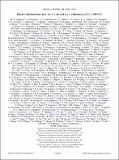Balance functions from Au+Au, d+Au, and p+p collisions at √sNN=200 GeV
Author(s)
Balewski, Jan T.; Betancourt, Michael Joseph; Corliss, Ross Cameron; Hays-Wehle, James Prewitt; Jones, Christopher LaDon; Kocoloski, Adam Philip; Leight, William Axel; Sakuma, Tai; Seele, Joseph Patrick; Surrow, Bernd; Hoffman, Alan Michael; Milner, Richard G; Redwine, Robert P; van Nieuwenhuizen, Gerrit J; Walker, Matthew H; ... Show more Show less
DownloadAggarwal-2010-Balance functions fr.pdf (1.668Mb)
PUBLISHER_POLICY
Publisher Policy
Article is made available in accordance with the publisher's policy and may be subject to US copyright law. Please refer to the publisher's site for terms of use.
Alternative title
Balance functions from Au+Au, d+Au, and p+p collisions at [square root] √sNN=200 GeV
Terms of use
Metadata
Show full item recordAbstract
Balance functions have been measured for charged-particle pairs, identified charged-pion pairs, and identified charged-kaon pairs in Au+Au, d+Au, and p+p collisions at [square root]√sNN=200 GeV at the Relativistic Heavy Ion Collider using the STAR detector. These balance functions are presented in terms of relative pseudorapidity, Δη [delta eta], relative rapidity, Δy [delta gamma], relative azimuthal angle, Δϕ [delta phi], and invariant relative momentum, q [subscript inv]. For charged-particle pairs, the width of the balance function in terms of Δη [delta eta] scales smoothly with the number of participating nucleons, while HIJING and UrQMD model calculations show no dependence on centrality or system size. For charged-particle and charged-pion pairs, the balance functions widths in terms of Δη [delta eta] and Δy [delta gamma]are narrower in central Au+Au collisions than in peripheral collisions. The width for central collisions is consistent with thermal blast-wave models where the balancing charges are highly correlated in coordinate space at breakup. This strong correlation might be explained by either delayed hadronization or limited diffusion during the reaction. Furthermore, the narrowing trend is consistent with the lower kinetic temperatures inherent to more central collisions. In contrast, the width of the balance function for charged-kaon pairs in terms of Δy [delta gamma] shows little centrality dependence, which may signal a different production mechanism for kaons. The widths of the balance functions for charged pions and kaons in terms of q [subscript inv] narrow in central collisions compared to peripheral collisions, which may be driven by the change in the kinetic temperature.
Date issued
2010-08Department
Bates Linear Accelerator Center; Massachusetts Institute of Technology. Department of Physics; Massachusetts Institute of Technology. Laboratory for Nuclear ScienceJournal
Physical review C
Publisher
American Physical Society
Citation
Aggarwal, M. et al. “Balance functions from Au+Au, d+Au, and p+p collisions at sqrt[s_{NN}]=200 GeV.” Physical Review C 82.2 (2010): n. pag. © 2010 The American Physical Society
Version: Final published version
ISSN
0556-2813